Pet Sitting vs Dog Walking: Which Business Should You Start?

If you’re looking to start a pet care business and need a little help deciding where to start, you’re in the right place! In this post, I’ll offer you two super popular pet care services to choose from: pet sitting vs dog walking.
First, I’ll explain what’s involved in each service, then discuss the pros and cons. Finally, I’ll help you compare the two and decide which best suits you.
If you’re wondering what my opinion is in just one sentence, here it is:
Pet sitting is a great side hustle to supplement to your main job, whereas dog walking is generally more suited to someone who wants to be involved in full-time pet care.
There’s more to it than that – but that’s the short answer if you’re pushing me.
Let’s dig a little deeper.
Want to know more about pet sitting in general? Check out this ultimate guide!
What is Pet Sitting? Your Guide to Caring for Furry Friends
Pet sitting is more than just popping in to feed Fluffy or Fido. It’s a responsible job that involves looking after someone’s beloved animals while they’re away.

The Basics of Pet Sitting
Pet sitting typically involves staying at the owner’s home to care for their pets or having them stay with you. This could be for a few hours, overnight, or even for weeks at a time.
Key responsibilities:
- Feeding and providing fresh water
- Walking dogs or playtime for cats
- Administering any necessary medications
- Cleaning litter boxes or picking up after dogs
- Providing lots of love and attention
Types of Pets You Might Care For
While dogs and cats are the most common, you could look after a range of animals.
Who might you look after as a pet sitter?
- Rabbits and guinea pigs
- Birds
- Fish
- Reptiles like snakes or lizards
- Even farm animals in some cases!
Each type of pet has its own needs, so it’s important to be clear about what animals you’re comfortable and experienced in caring for.
How long are Pet Sitting Assignments?
Pet sitting gigs can vary widely in length.
- Short visits: These might be 30-60 minute pop-ins for feeding and a quick walk.
- Day-long stays: Perfect for pets that need more attention or exercise throughout the day.
- Overnight stays: Common for owners on weekend trips or short holidays.
- Extended stays: These can last anywhere from a week to several months for owners on long trips or working abroad.
Beyond Basic Care
Pet sitting often involves more than just animal care.
What else might a pet sitter be asked to do?
- Bring in post
- Water plants
- Take rubbish bins out
- Provide basic house sitting services
Building Trust with Pet Owners
Trust is essential in pet sitting. Building a good reputation is necessary for success.
Tips for building trust
- Be transparent about your experience and capabilities
- Offer to meet the pets before the sitting assignment
- Provide regular updates and photos to the owners while they’re away
- Always follow the owner’s instructions and routines
What is Dog Walking? More Than Just a Stroll in the Park
If you think dog walking is simply clipping on a lead and taking a casual stroll, you might be surprised! Professional dog walking is a structured service that provides exercise, mental stimulation, and relief for our canine friends.

The Nuts and Bolts of Dog Walking Services
As a dog walker, your main job is to take dogs out for exercise when their owners can’t. But it’s not just about physical activity. You’re also responsible for the dog’s safety, behaviour, and well-being during the walk.
Typical dog walking services
- Picking up the dog from the owner’s home
- Securely leashing and walking the dog for a set time
- Providing water and sometimes treats
- Cleaning up any mess
- Returning the dog safely to its home
How Long is a Dog Walk?
The length of a dog walk can vary, but most professional services offer standard time slots. Here’s a rough guide:
- Short walks: Usually 15-20 minutes, ideal for older dogs or quick toilet breaks
- Standard walks: Typically 60 minutes, suitable for most dogs’ daily exercise needs
- Extended walks: Often 60-90 minutes, great for high-energy breeds or dogs left alone for long periods
It’s Not Just Walking
Dog walking often comes with additional services.
What else might a dog walker be asked to do?
- Feed the dog before or after the walk
- Refresh water bowls
- Provide basic grooming like brushing
- Administer medications
- Offer playtime or training reinforcement
Understanding Canine Behaviour is Key
Being a good dog walker isn’t just about loving dogs (though that helps!). You need to understand dog behaviour and body language.
Why should you understand dog behaviour?
- Keeping the dogs safe and under control
- Managing multiple dogs if you’re doing group walks
- Dealing with unexpected situations like aggressive dogs or wildlife encounters
- Providing mental stimulation through training reinforcement
Safety first: Always prioritise the safety of the dogs, yourself, and others. This might mean investing in proper equipment like sturdy leads, harnesses, and poo bags.
The Schedule of a Dog Walker
Dog walking tends to follow a more structured schedule than pet sitting. Most walks happen during the working week, with peak times being:
- Mid-morning (around 10-11 am)
- Lunchtime (12-2 pm)
- Mid-afternoon (2-4 pm)
Weekend and evening walks are less common but can be a good way to expand your service if there’s demand in your area.
Building a Clientele
Success as a dog walker often depends on building a regular client base.
This means:
- Being reliable and punctual
- Communicating clearly with owners
- Providing consistent, high-quality care
- Being flexible to meet different dogs’ needs
Many dog walkers use apps or software to schedule walks, track payments, and send updates to owners. These tools can make your job easier and more professional.
Pet Sitting vs Dog Walking: Which Fits Your Lifestyle?
So, you’re keen on working with animals, but you need to figure out whether pet sitting or dog walking is the better fit for you. No worries! Let’s break down the key differences to help you make an informed decision.
Time Commitment: Long Stays vs Quick Visits

Pet Sitting:
- Often involves longer assignments, from a few hours to several days or weeks
- May require overnight stays at the client’s home
- Can be less predictable, depending on when owners go on holiday or business trips
Dog Walking:
- Usually consists of shorter, more frequent commitments
- Typically 30-60 minute walks per dog
- Often follows a more regular schedule, with walks at similar times each day
Which suits you? If you prefer a flexible schedule with the potential for longer assignments, pet sitting might be your cup of tea. Dog walking could be the way to go if you like structure and shorter, regular commitments.
Physical Demands: Couch Potato or Fitness Enthusiast?
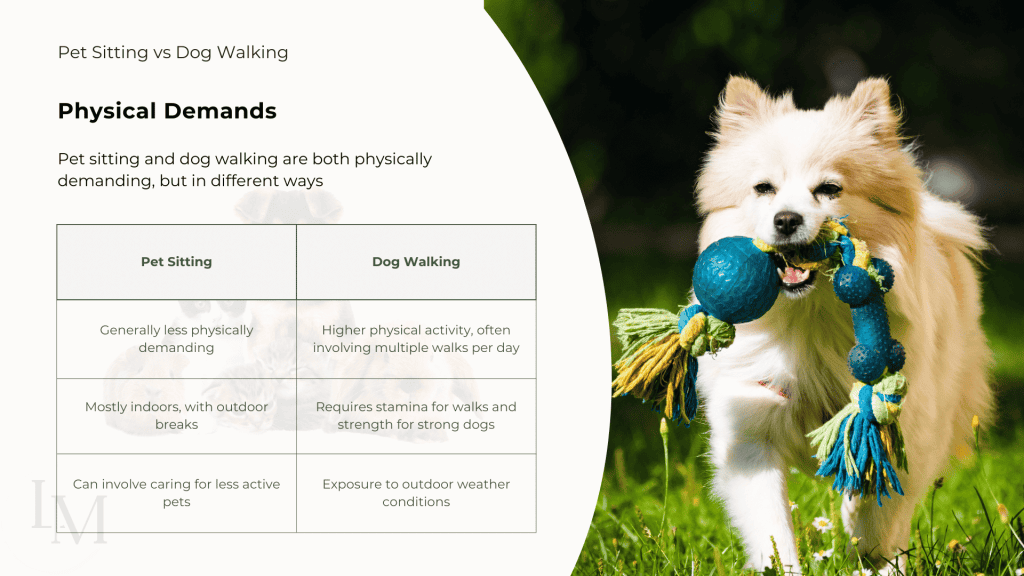
Pet Sitting:
- Generally less physically demanding
- Mostly indoor work, with occasional walks or playtime
- Can involve caring for less active pets like cats, fish, or small mammals
Dog Walking:
- Higher physical activity, often involving multiple walks per day
- Requires stamina for longer walks and the ability to control strong dogs
- Exposes you to various weather conditions
Consider this: Dog walking could be a great fit if you enjoy being active and don’t mind braving the elements. If you prefer a less physically demanding role with more variety in pet types, pet sitting might be more your speed.
Earning Potential: Show Me the Money!

Pet Sitting:
- Can command higher rates, especially for overnight stays
- Potential for longer bookings, leading to more stable income during peak times
- Rates in the UK typically range from £20-£50 per day, depending on location and services
Dog Walking:
- Generally lower hourly rate, but potential for multiple clients in a day
- More consistent income throughout the year
- UK rates usually range from £10-£20 per hour-long walk
Money matters: While pet sitting can offer higher pay per job, dog walking might provide more consistent work. Your earning potential in either field can increase with experience and positive reviews.
Required Skills: What’s in Your Toolbox?
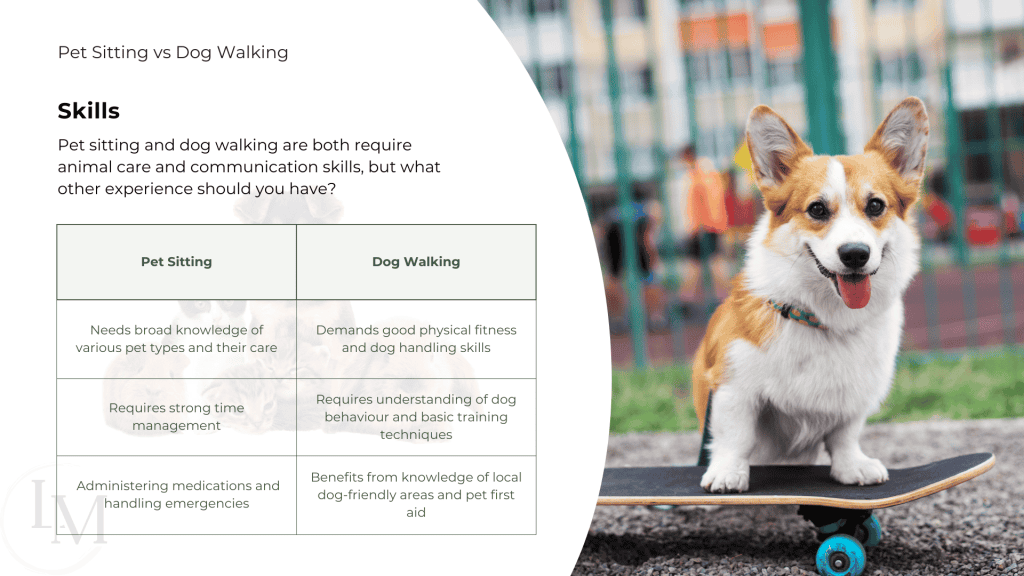
Pet Sitting:
- Needs broad knowledge of various pet types and their care
- Requires strong time management and responsibility (you could be caring for someone’s home too!)
- Benefits from skills in administering medications and handling emergencies
Dog Walking:
- Demands good physical fitness and dog handling skills
- Requires understanding of dog behaviour and basic training techniques
- Benefits from knowledge of local dog-friendly areas and pet first aid
Skill check: Both roles require a love for animals and good communication skills. Pet sitting might suit you if you’re a jack-of-all-trades, while dog walking could be perfect if you’re passionate about canines specifically.
Target Market: Who Are Your Clients?
Pet Sitting:
- Often caters to holiday makers and business travellers
- Popular among owners of cats, small pets, and dogs that don’t do well in kennels
- Can be in high demand during the holiday seasons
Dog Walking:
- Typically serves busy professionals, elderly pet owners, or those with limited mobility
- Focuses mainly on dog owners, particularly those with high-energy breeds
- Often has more consistent demand throughout the year
Flexibility and Work Environment
Pet Sitting:
- Offers variety in work environments (different homes and pets)
- Can provide quiet time for other activities while pets are resting
- Might require you to be available on specific dates
Dog Walking:
- Provides a more consistent outdoor work environment
- Offers potential for socialising with other dog walkers and pet owners
- Allows for a more structured daily routine
Lifestyle fit: Consider how each option would fit into your current lifestyle. Do you prefer variety or routine? Are you comfortable staying in others’ homes, or do you prefer being outdoors?
The Ups and Downs of Pet Sitting: What You Need to Know
Pet sitting is a rewarding gig, but like any job, it has its fair share of positives and negatives.
The Bright Side: Pros of Pet Sitting
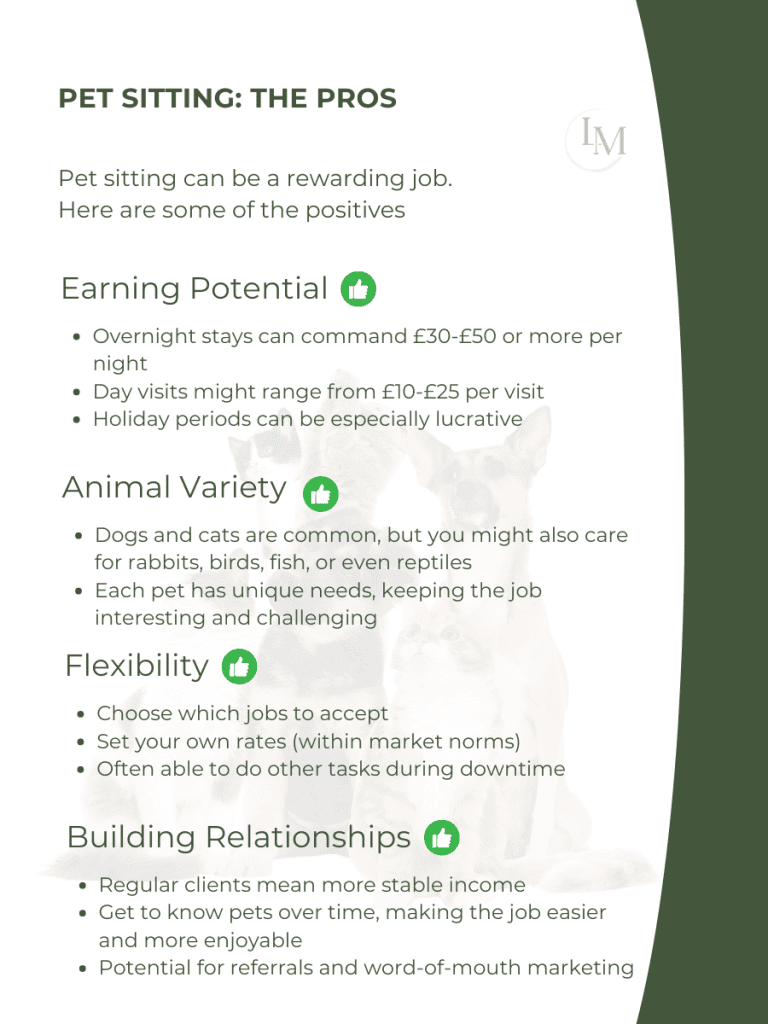
1. Potential for Higher Earnings
One of the biggest draws of pet sitting is the potential to earn more per job compared to other pet care services.
Earning potential:
- Overnight stays can command £30-£50 or more per night
- Day visits might range from £10-£25 per visit
- Holiday periods can be especially lucrative
Remember, your rates can increase as you gain experience and positive reviews.
2. Variety is the Spice of Life
Pet sitting could be your dream job if you love animals of all shapes and sizes.
Animal variety:
- Dogs and cats are common, but you might also care for rabbits, birds, fish, or even reptiles
- Each pet has unique needs, keeping the job interesting and challenging
3. Flexibility and Independence
Pet sitting often offers more flexibility than traditional 9-to-5 jobs.
Flexible aspects:
- Choose which jobs to accept
- Set your own rates (within market norms)
- Often able to do other tasks during downtime
This flexibility can be especially appealing if you use pet sitting as a side hustle.
4. Building Lasting Relationships
Pet sitting often leads to repeat business and long-term client relationships.
Relationship benefits:
- Regular clients mean more stable income
- Get to know pets over time, making the job easier and more enjoyable
- Potential for referrals and word-of-mouth marketing
The Challenges: Cons of Pet Sitting
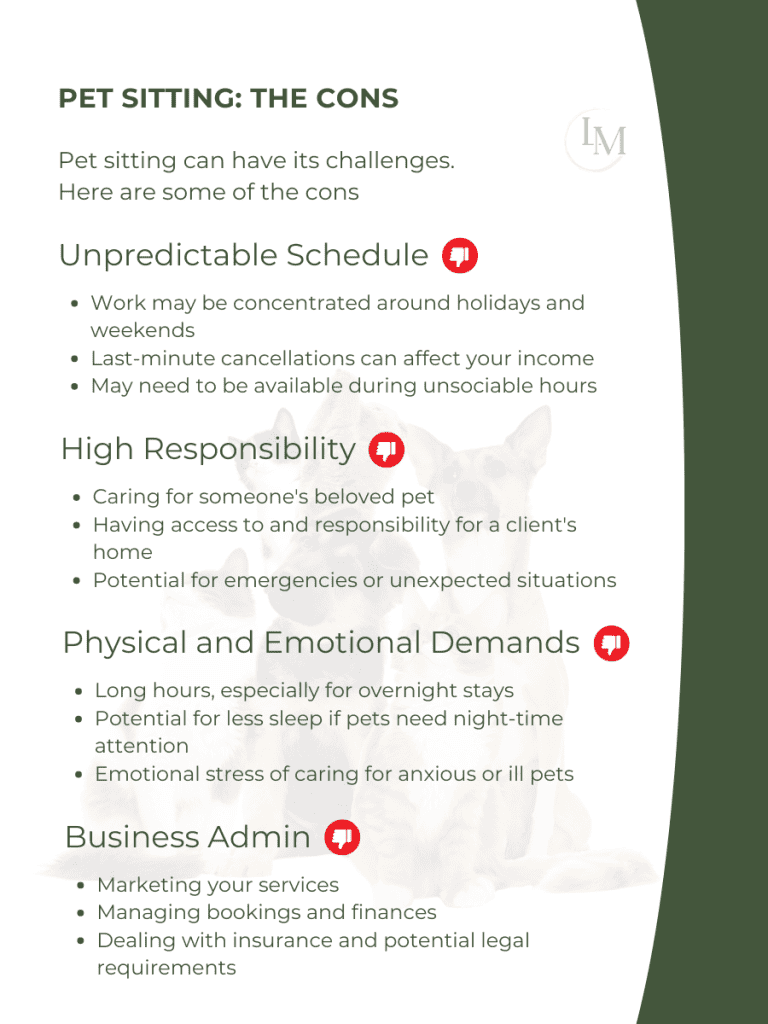
1. Unpredictable Schedule
While flexibility is a pro, it can also be a con if you prefer a stable routine.
Schedule challenges:
- Work may be concentrated around holidays and weekends
- Last-minute cancellations can affect your income
- May need to be available during unsociable hours
2. High Responsibility
Pet sitting involves more than just playing with cute animals. It comes with big responsibilities.
Responsibility factors:
- Caring for someone’s beloved pet
- Having access to and responsibility for a client’s home
- Potential for emergencies or unexpected situations
This level of responsibility can be stressful, especially when you’re just starting out.
3. Physical and Emotional Demands
Pet sitting can be more demanding than it might first appear.
Demands to consider:
- Long hours, especially for overnight stays
- Potential for less sleep if pets need night-time attention
- Emotional stress of caring for anxious or ill pets
It’s important to consider your wellbeing and set boundaries where necessary.
4. Business Management
As a pet sitter, you’re essentially running your own small business.
Business tasks:
- Marketing your services
- Managing bookings and finances
- Dealing with insurance and potential legal requirements
These additional tasks can be time-consuming and may not appeal to everyone.
5. Isolation
Pet sitting, especially for longer assignments, can sometimes be a solitary job.
Isolation factors:
- Long periods alone in someone else’s home
- Limited human interaction during assignments
- Potential for feeling disconnected from your own life and routines
This aspect might be challenging if you’re a very social person.
Is Pet Sitting Right for You?
Weighing these pros and cons can help you decide whether pet sitting fits your lifestyle and personality.
If you love animals, enjoy variety, and are comfortable with responsibility, the pros might outweigh the cons.
On the other hand, if you prefer a predictable schedule and find the idea of managing your own business daunting, consider other options.
Sniffing Out the Pros and Cons of Dog Walking
Dog walking is also a super rewarding job, but there’s a lot to think about before wandering down this path. Let’s take a stroll through the pros and cons. This way, you’ll know exactly what you’re getting into – both the tail-wagging good bits and the occasional muddy puddles.
The Pawsitive Side: Pros of Dog Walking
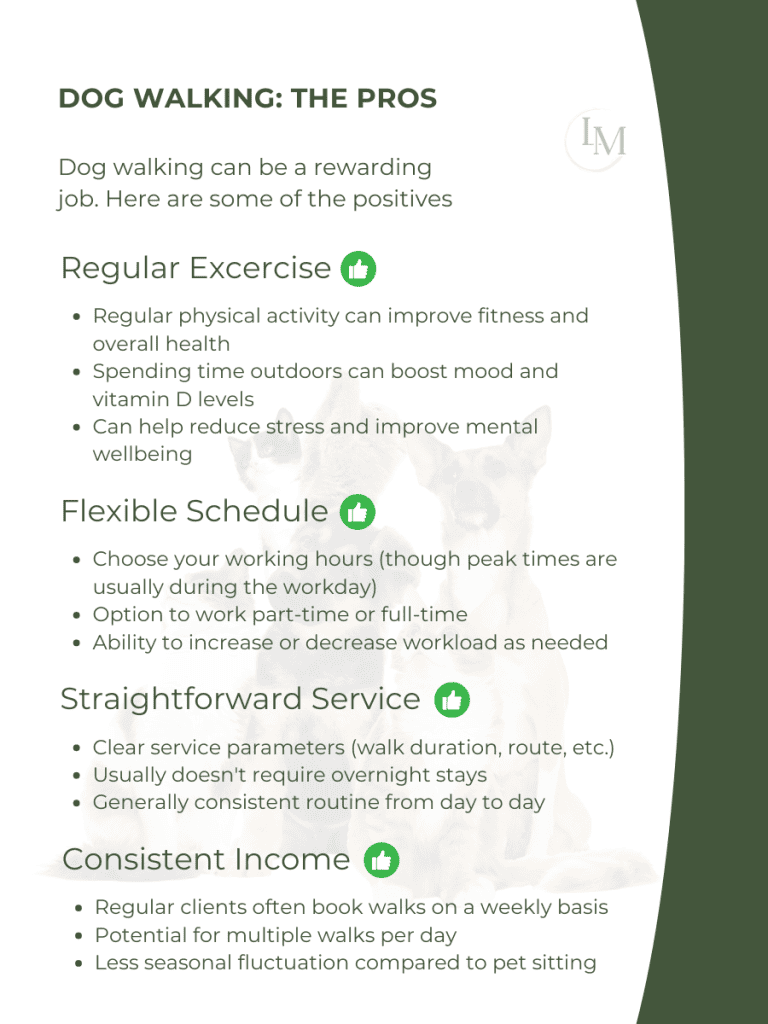
1. Regular Exercise and Fresh Air
If you’re not a fan of being cooped up indoors, dog walking could be your ticket to a more active lifestyle.
Health benefits:
- Regular physical activity can improve fitness and overall health
- Spending time outdoors can boost mood and vitamin D levels
- Can help reduce stress and improve mental wellbeing
2. Flexible Schedule
Dog walking often allows for flexibility in your work hours.
Schedule perks:
- Choose your working hours (though peak times are usually during the workday)
- Option to work part-time or full-time
- Ability to increase or decrease workload as needed
This flexibility can be particularly appealing if you balance dog walking with other commitments.
3. Straightforward Service
Compared to some other pet care services, dog walking is relatively straightforward.
Simplicity factors:
- Clear service parameters (walk duration, route, etc.)
- Usually doesn’t require overnight stays
- Generally consistent routine from day to day
This simplicity can make it easier to manage and scale your business.
4. Consistent Income Potential
While individual walks might not pay as much as overnight pet sitting, dog walking can offer more consistent work.
Income aspects:
- Regular clients often book walks on a weekly basis
- Potential for multiple walks per day
- Less seasonal fluctuation compared to pet sitting
With a solid client base, you can build a reliable income stream.
5. Bonding with Dogs
For dog lovers, this job is a dream come true!
Canine connection:
- Spend your days with a variety of furry friends
- Build relationships with regular canine clients
- Enjoy the unconditional love and excitement dogs offer
There’s nothing quite like being greeted with a wagging tail every day at work.
The Ruff Patches: Cons of Dog Walking
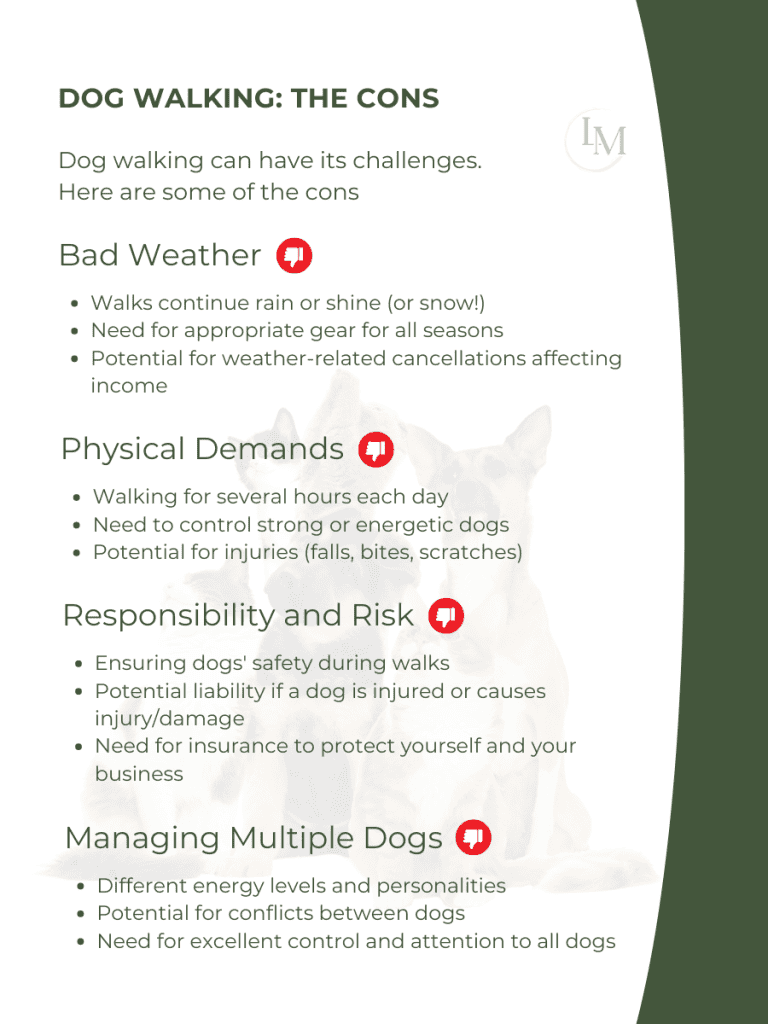
1. Weather Woes
As a dog walker, you’ll be outdoors in all sorts of weather conditions.
Weather challenges:
- Walks continue rain or shine (or snow!)
- Need for appropriate gear for all seasons
- Potential for weather-related cancellations affecting income
You’ll need to be prepared for whatever the weather throws at you.
2. Physical Demands
Dog walking is more physically demanding than many people realise.
Physical considerations:
- Walking for several hours each day
- Need to control strong or energetic dogs
- Potential for injuries (falls, bites, scratches)
It’s important to be honest about your physical capabilities and limitations.
3. Responsibility and Risk
You’re responsible for the safety and wellbeing of someone’s beloved pet.
Responsibility factors:
- Ensuring dogs’ safety during walks
- Potential liability if a dog is injured or causes injury/damage
- Need for insurance to protect yourself and your business
This level of responsibility can be stressful, especially when handling multiple dogs.
4. Limited Earning Potential Per Job
While dog walking can provide consistent work, individual walks typically pay less than longer pet-sitting assignments.
Earning considerations:
- Average rates in the UK range from £10-£20 per hour-long walk
- Need to factor in travel time between clients
- Potential for unpaid time (e.g., meet-and-greets with new clients)
You may need to build up a large client base to earn a full-time income.
5. Managing Multiple Dogs
It can be challenging if you’re walking multiple dogs at once to increase earnings.
Multi-dog challenges:
- Different energy levels and personalities
- Potential for conflicts between dogs
- Need for excellent control and attention to all dogs
While walking multiple dogs can be more profitable, it also increases responsibility and potential stress.
6. Business Management
Like pet sitting, dog walking requires you to manage your own business.
Business tasks:
- Marketing and client acquisition
- Scheduling and invoicing
- Tax and insurance considerations
These additional responsibilities might not appeal to everyone.
Is Dog Walking Your Perfect Match?
After sniffing out these pros and cons, do you think dog walking is the right fit for you?
If you love dogs, enjoy being active outdoors, and don’t mind some unpredictable weather, the pros might have your tail wagging.
On the other hand, if you prefer a less physical job or struggle with being out in all weathers, you might want to consider other options.
Making the Choice: Pet Sitting vs Dog Walking
Now that we’ve weighed the pros and cons of pet sitting and dog walking, it’s time to choose.
Assess Your Personal Preferences and Lifestyle
Your own likes, dislikes, and current lifestyle play a huge role in determining which service might be a better fit.
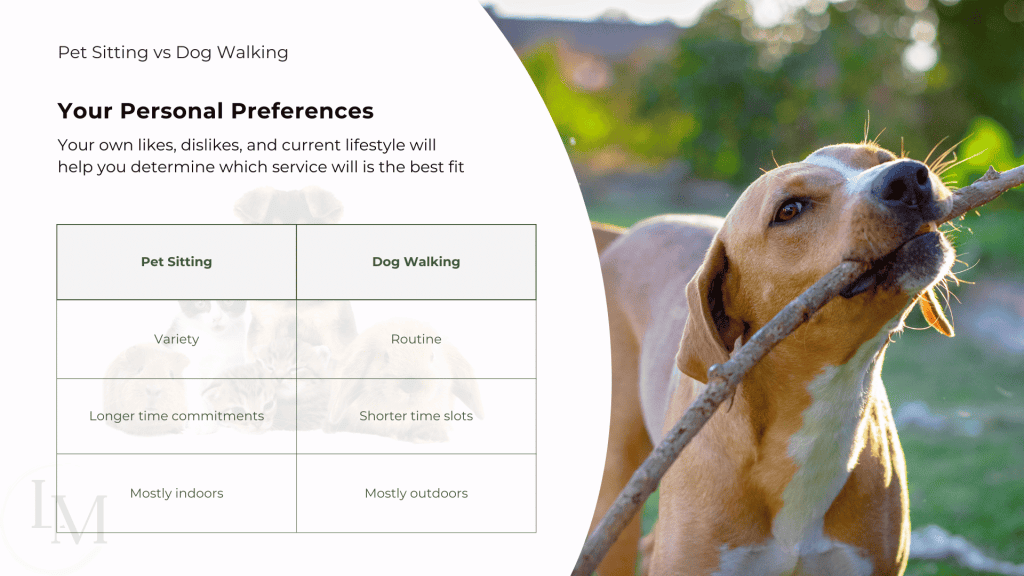
Consider these factors:
- Do you prefer variety or routine? Pet sitting offers more variety in terms of animals and environments, while dog walking provides a more consistent routine.
- How much time can you commit? Pet sitting often requires longer time commitments, while dog walking can be more flexible with shorter time slots.
- Are you a homebody or an outdoor enthusiast? If you love being outdoors in all weather, dog walking might be more appealing. If you prefer indoor work, pet sitting could be a better match.
Action step: Write down your preferences for each of these factors. This can help clarify which service aligns better with your personal style.
Evaluate Your Physical Capabilities
Both pet sitting and dog walking can be physically demanding, but in different ways.
Physical considerations:
- Stamina: Dog walking requires more consistent physical activity. Can you handle multiple walks a day?
- Strength: Can you control large or strong dogs on a lead?
- Sleep habits: Are you okay with potentially disrupted sleep for overnight pet sitting?
Action step: Be honest with yourself about your physical capabilities and limitations. It’s important to choose a service that won’t strain you physically.
Assess Your Schedule Flexibility
Your availability and desired work schedule can influence which service is more suitable.

Schedule factors:
- Do you prefer short, regular commitments or longer, less frequent ones? Dog walking typically involves daily walks, while pet sitting might mean longer stays but less frequently.
- Are you available on weekends and holidays? These are often busy times for pet sitters.
- Do you need a predictable income? Dog walking often provides more consistent work throughout the year.
Action step: Map out your ideal work schedule. Which service best suits your availability and income needs?
Consider Your Local Market
The demand for pet sitting and dog walking can vary depending on your location.
Market research:
- Demographics: Areas with many young professionals might need more dog walkers, while places with lots of families might need more pet sitters during school holidays.
Action step: Do some research on pet care needs in your local area. You could even survey pet owners in your community to gauge demand.
Evaluate Your Skill Set
While both services require a love for animals, they do need slightly different skill sets.
Skills to consider:
- Animal handling: Are you comfortable with a wide range of animals, or do you prefer to stick with dogs?
- Home management: Pet sitting often involves basic home care tasks. Are you comfortable with this responsibility?
- Physical fitness: Dog walking requires a good level of fitness. How’s your stamina?
Action step: List your relevant skills and experiences. Which service makes the best use of your current abilities?
The Hybrid Approach
Offering both services is possible. Many pet care professionals do both to maximise their client base and income potential.
Hybrid benefits:
- Diverse income streams: Less reliance on one type of service
- Ability to meet more client needs: Offering both services can make you a one-stop shop for pet care
- Variety in your work: Reduces the chance of burnout
Action step: Consider if a combination of both services could work for you. How might you balance the two?
Conclusion: Dog Walking vs Pet Sitting
As you can see, pet sitting and dog walking are two related but different pet care services.
Pet sitting might suit someone who is more flexible with their time, doesn’t mind a fluctuating income and is happy to have pets stay overnight in their homes.
Dog walking is more suited to those who like structure, predictable income and can handle the responsibility of looking after lots of animals at the same time.
If you want to dabble in both before deciding which service suits you best, why not try a pet care platform, where you can offer a bunch of different services and turn them on and off at the click of a button?
In my experience, most of the pet sitters I know run their businesses as side incomes, whereas most of the dog walkers I know run their services as full-time businesses.






